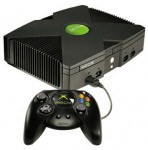Powet Alphabet: X is for Xbox
by FakeTrout, filed in Powet Alphabet on Jun.12, 2010
 March 10, 2000 is widely regarded as the peak of the “dot com boom” with the Nasdaq hitting an all time high. This is an interesting historical foot note as its the day tech giant Microsoft announced they were getting into home video game business.
March 10, 2000 is widely regarded as the peak of the “dot com boom” with the Nasdaq hitting an all time high. This is an interesting historical foot note as its the day tech giant Microsoft announced they were getting into home video game business.
Going back a long time, its kind of interesting to look at how the game business evolved, or more accurately grew up. Atari and the NES were for kids. 16 bit era added a layer of complexity to keep older kids interested. In the mid 90s, Sony’s Playstation kept teenagers playing with more mature games. As the Atari and NES kids grew up it would take a big evolutionary leap to keep games in their lives and into the dorm rooms. Thats what I think of the original Xbox: the first console built for dorm rooms.
Xbox was orignally short hand for “Direct X Box” as Seamus Blackley was convinced that there was no way the Playstation 2 (then still in development) could compete with the power of a PC. And thats basically what the Xbox was. Stock parts assembled in a massive case: off the shelf 733 Inten Pentium III chip, nVidea graphics card, and custom Windows NT operating system. The controllers ports were basically just USB with a custom plug.
 For the Nintendo kids, it was another competitor to take away their already diminished market share. Sony didn’t sweat and kept plugging away. Dreamcast was on its way out the door by the time Xbox launched. Xbox represented a strange new competitor, since it had been generations since a US based company had done well with video game hardware, outside of Microsoft who touted that they already had the world’s biggest game platform in the PC. Launch titles seemed calculated to the older audience: Project Gotham Racing, Tony Hawk 2, Madden NFL 2002, Dead Or Alive 3, and Halo headlined the November 15, 2001 release date. Only Oddworld seemed appropriate for a younger crowd.
For the Nintendo kids, it was another competitor to take away their already diminished market share. Sony didn’t sweat and kept plugging away. Dreamcast was on its way out the door by the time Xbox launched. Xbox represented a strange new competitor, since it had been generations since a US based company had done well with video game hardware, outside of Microsoft who touted that they already had the world’s biggest game platform in the PC. Launch titles seemed calculated to the older audience: Project Gotham Racing, Tony Hawk 2, Madden NFL 2002, Dead Or Alive 3, and Halo headlined the November 15, 2001 release date. Only Oddworld seemed appropriate for a younger crowd.
 Xbox was a success, and seemed to actually inherit some of the Dreamcast legacy. Its controller was remarkably similar, right down the the 2 huge ports for memory cards. Sequels that might have appeared on Dreamcast instead went exclusively to Xbox: Crazy Taxi 3, Jet Set Radio Future, Panzer Dragoon Orta, Shenmue 2, and Sega GT among others.
Xbox was a success, and seemed to actually inherit some of the Dreamcast legacy. Its controller was remarkably similar, right down the the 2 huge ports for memory cards. Sequels that might have appeared on Dreamcast instead went exclusively to Xbox: Crazy Taxi 3, Jet Set Radio Future, Panzer Dragoon Orta, Shenmue 2, and Sega GT among others.
But the true effect that Xbox had wasn’t in the living room (though it did have 4 controller ports and plenty of games to support them), but online. When the console launched in 2001, broadband internet wasn’t widely available. Halo supported LAN play, by connecting 2 or more consoles together to double the number of players.
 In 2002, Microsoft launched Xbox Live, the first premium online game service on a console. Sega had tried online with Dreamcast and Saturn, but dialup wasn’t a good experience and providers that supported the consoles were few. Xbox by comparison required little set up: just a router or a direct connection to your cable or DSL modem and code you redeemed with a prepaid membership kid (or credit card). Headsets were standard, as typing to chat during games would take you off the controller. A single login for every game, and the ability to make up a friend list to see when others were online and what they were playing made for a very tight early community.
In 2002, Microsoft launched Xbox Live, the first premium online game service on a console. Sega had tried online with Dreamcast and Saturn, but dialup wasn’t a good experience and providers that supported the consoles were few. Xbox by comparison required little set up: just a router or a direct connection to your cable or DSL modem and code you redeemed with a prepaid membership kid (or credit card). Headsets were standard, as typing to chat during games would take you off the controller. A single login for every game, and the ability to make up a friend list to see when others were online and what they were playing made for a very tight early community.
The first two years of Xbox Live were highlighted by Ghost Recon, Mech Assault, Crimson Skies, and a variety of sports games. It was a pretty good time, but there was always an emptiness: Halo, the systems best reviewed and highest selling game, did not support the service.
 November 9, 2004 was the release of Halo 2. It sold by the millions, becoming the banner game for the console and Xbox Live service. It stayed the most popular game for 2 years after release, a feat unlikely to be ever repeated by another game. The epic single player was only the beginning of the experience, as a robust multiplayer with optional map packs offering unlimited replay.
November 9, 2004 was the release of Halo 2. It sold by the millions, becoming the banner game for the console and Xbox Live service. It stayed the most popular game for 2 years after release, a feat unlikely to be ever repeated by another game. The epic single player was only the beginning of the experience, as a robust multiplayer with optional map packs offering unlimited replay.
Sadly, it would be less than a year later that Xbox would begin to decline. Conker Live And Reloaded was the last game Microsoft published for the original Xbox in June 2005, and the successor system, Xbox 360 would release to an instant sell out in November the same year. Third parties continued to support the console for the next few years, and Madden 2009 became the last game to be released in August 2008. On April 15, 2010 Microsoft deactivated the original Xbox Live servers, thus finally ending all support of the box that put them on the map.
Xbox had just 4 years from release to the release of the Xbox 360, an extremely short time for a successful system. The very things that made the machine quick to design and build ended up making it too expensive to produce, which is why Microsoft rushed the next generation to market. Yet, in that time it went from a laughable black box with a terrible pitch and a controller for giants, to the world leader in the next chapter of console gaming with Xbox Live.


 PS3
PS3
 Famicom Dojo
Famicom Dojo KEEP PLAYING
KEEP PLAYING KEEP PLAYING: Rewind
KEEP PLAYING: Rewind Powet Toys
Powet Toys Powetcast
Powetcast Hitchhiker's Guide POWETcast
Hitchhiker's Guide POWETcast















Pingback: Happy 15th Birthday Xbox ! - POWET.TV: Games, Comics, TV, Movies, and Toys